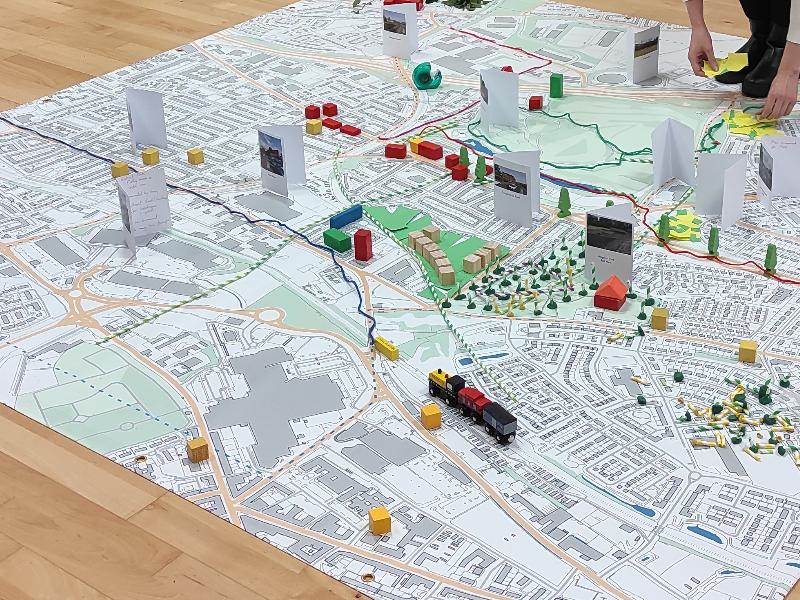Glasgow community-led liveable neighbourhood plans strive to reduce car dependency

More areas of Glasgow are in line for the next stages of Liveable Neighbourhoods development
Glasgow’s Liveable Neighbourhoods are set to reduce the city’s car dependency by transforming streets into safer, more attractive spaces where everyday needs can be met locally and where people travelling actively and by public transport are prioritised.
The climate crisis and recent pandemic have brought to the fore the importance of local public space. As a key element of Glasgow’s Transport Strategy the Liveable Neighbourhoods Programme is advancing a network of accessible and revitalised neighbourhoods with enhanced public spaces and attractive green infrastructure.
At the heart of programme development are residents who have been participating in activities to identify an array of neighbourhood improvements that reflect the needs of their communities, some of which will progress to construction, subject to future funding availability.
This participative process started last year with the publication of our Liveable Neighbourhoods Toolkit and subsequent in-person and online engagement with communities. By looking at everyday journeys, the toolkit helps local people identify areas that require interventions, mapping out a pathway which meets their needs.
Funded by Sustrans Scotland Connecting Communities fund, the first tranche of work co-designed with residents across five Liveable Neighbourhoods has progressed at pace. Reports presented to Environment Committee today highlighted shortlisted projects where design proposals will be developed for Liveable Neighbourhoods at Dennistoun to Cranhill and Govan to Kingston. These include improvements to local space at Riddrie Town Centre, Carntyne Square and on Lorne Street and Govan Road.
Councillors also noted the Yorkhill to Anderston Liveable Neighbourhood report which includes a long list of suggested interventions as well as a review of current initiatives such as the Yorkhill and Kelvingrove Cycling Village, and proposals for Old Dumbarton Road. Future analysis will narrow down a list of projects for design work, funded by Sustrans Scotland Places for Everyone fund.
Similar reports that highlighted shortlisted projects were published earlier this year for Liveable Neighbourhoods at Ruchill to Cowlairs and Langside to Toryglen with proposed interventions for next stage development work including Saracen Street public realm and work in Mount Florida to support the town centre along Cathcart Road.
Councillor Angus Millar, city convener for climate and transport, said: “It’s exciting to see plans for the first set of Liveable Neighbourhoods starting to take shape. This approach is about looking at Glasgow street by street, community by community, and finding ways to connect and improve our local neighbourhoods.
“The first tranche of projects taken forward for further development includes locations across the north and southside of the city, from safer and more attractive public realm in Ruchill, to streetscape improvements around the Battle of Langside monument and the development of underused greenspace in Toryglen. Communities all across the city will be involved over the next few years to identify improvements that can be made, with the latest round of engagement producing ideas to transform streets and promote active travel in areas from Dennistoun/Cranhill to Govan/Kingston and Yorkhill/Anderston.
“Interventions for each Liveable Neighbourhood such as reducing traffic flow or making it easier to walk or cycle to the shops have the potential to collectively deliver rebalanced, safer streets that make a real difference to people’s quality of life. Our early-stage work is really driven by community groups and residents, drawing out the needs and aspirations of local people and setting out how we can enable residents to have their day-to-day needs met within a short distance of their home and create streets that are more suitable for walking, wheeling and cycling. That will help make active travel a more natural choice for local journeys, reducing car dependency and cutting carbon emissions, as well as encouraging greater footfall to local shops and businesses.”
The Liveable Neighbourhoods Programme is Glasgow’s approach to blending the 20-minute neighbourhood concept with the place principle to respond to the current environmental, social, health and economic challenges the city faces.
Other areas in line for the next stages of Liveable Neighbourhoods development are:
- Pollokshaws, Mansewood, Pollokshields West, Shawlands and Strathbungo
- Greater Gorbals, Govanhill and Pollokshields East
- Sighthill, Roystonhill, Germiston, Blackhill and Hogganfield
- Yoker, Scotstoun, Jordanhill and Whiteinch
Details of future phases, covering other parts of the city will follow as soon as possible.
In the months ahead, the public conversation will continue through engagement and with the use of online and in-person public events to collaboratively identify interventions that can be undertaken for each neighbourhood, with local communities being actively involved.





















